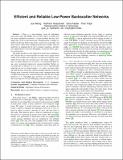| dc.contributor.author | Wang, Jue | |
| dc.contributor.author | Hassanieh, Haitham | |
| dc.contributor.author | Katabi, Dina | |
| dc.contributor.author | Indyk, Piotr | |
| dc.date.accessioned | 2014-05-15T17:48:36Z | |
| dc.date.available | 2014-05-15T17:48:36Z | |
| dc.date.issued | 2012-09 | |
| dc.date.submitted | 2012-08 | |
| dc.identifier.issn | 01464833 | |
| dc.identifier.issn | 1943-5819 | |
| dc.identifier.uri | http://hdl.handle.net/1721.1/87004 | |
| dc.description.abstract | There is a long-standing vision of embedding backscatter nodes like RFIDs into everyday objects to build ultra-low power ubiquitous networks. A major problem that has challenged this vision is that backscatter communication is neither reliable nor efficient. Backscatter nodes cannot sense each other, and hence tend to suffer from colliding transmissions. Further, they are ineffective at adapting the bit rate to channel conditions, and thus miss opportunities to increase throughput, or transmit above capacity causing errors.
This paper introduces a new approach to backscatter communication. The key idea is to treat all nodes as if they were a single virtual sender. One can then view collisions as a code across the bits transmitted by the nodes. By ensuring only a few nodes collide at any time, we make collisions act as a sparse code and decode them using a new customized compressive sensing algorithm. Further, we can make these collisions act as a rateless code to automatically adapt the bit rate to channel quality --i.e., nodes can keep colliding until the base station has collected enough collisions to decode. Results from a network of backscatter nodes communicating with a USRP backscatter base station demonstrate that the new design produces a 3.5× throughput gain, and due to its rateless code, reduces message loss rate in challenging scenarios from 50% to zero. | en_US |
| dc.description.sponsorship | National Science Foundation (U.S.) | en_US |
| dc.description.sponsorship | Interconnect Focus Center (United States. Defense Advanced Research Projects Agency and Semiconductor Research Corporation) | en_US |
| dc.language.iso | en_US | |
| dc.publisher | Association for Computing Machinery (ACM) | en_US |
| dc.relation.isversionof | http://dx.doi.org/10.1145/2377677.2377685 | en_US |
| dc.rights | Creative Commons Attribution-Noncommercial-Share Alike | en_US |
| dc.rights.uri | http://creativecommons.org/licenses/by-nc-sa/4.0/ | en_US |
| dc.source | MIT web domain | en_US |
| dc.title | Efficient and reliable low-power backscatter networks | en_US |
| dc.type | Article | en_US |
| dc.identifier.citation | Wang, Jue, Haitham Hassanieh, Dina Katabi, and Piotr Indyk. “Efficient and Reliable Low-Power Backscatter Networks.” ACM SIGCOMM Computer Communication Review 42, no. 4 (September 24, 2012): 61. | en_US |
| dc.contributor.department | Massachusetts Institute of Technology. Department of Electrical Engineering and Computer Science | en_US |
| dc.contributor.mitauthor | Wang, Jue | en_US |
| dc.contributor.mitauthor | Hassanieh, Haitham | en_US |
| dc.contributor.mitauthor | Katabi, Dina | en_US |
| dc.contributor.mitauthor | Indyk, Piotr | en_US |
| dc.relation.journal | ACM SIGCOMM Computer Communication Review | en_US |
| dc.eprint.version | Author's final manuscript | en_US |
| dc.type.uri | http://purl.org/eprint/type/JournalArticle | en_US |
| eprint.status | http://purl.org/eprint/status/PeerReviewed | en_US |
| dspace.orderedauthors | Wang, Jue; Hassanieh, Haitham; Katabi, Dina; Indyk, Piotr | en_US |
| dc.identifier.orcid | https://orcid.org/0000-0002-6689-8189 | |
| dc.identifier.orcid | https://orcid.org/0000-0003-4854-4157 | |
| dc.identifier.orcid | https://orcid.org/0000-0002-7983-9524 | |
| mit.license | OPEN_ACCESS_POLICY | en_US |
| mit.metadata.status | Complete | |
